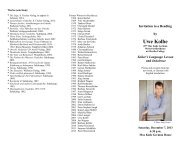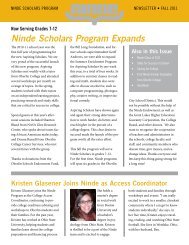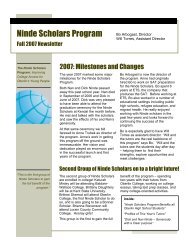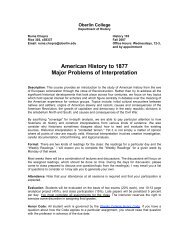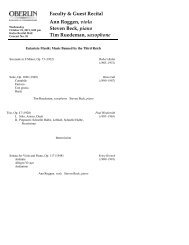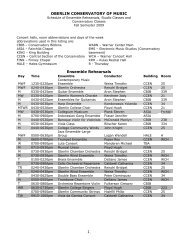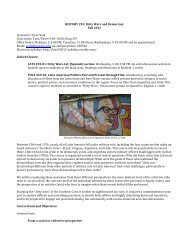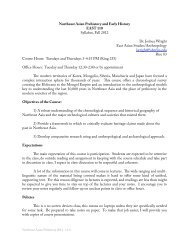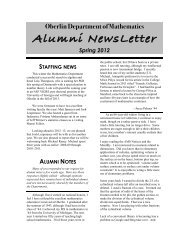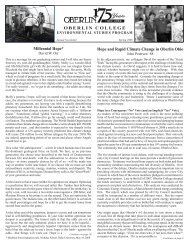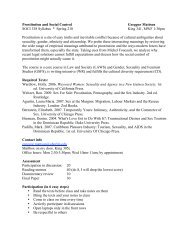Oberlin College Department of History HIST 285: American Indians ...
Oberlin College Department of History HIST 285: American Indians ...
Oberlin College Department of History HIST 285: American Indians ...
Create successful ePaper yourself
Turn your PDF publications into a flip-book with our unique Google optimized e-Paper software.
<strong>Oberlin</strong> <strong>College</strong><br />
<strong>Department</strong> <strong>of</strong> <strong>History</strong><br />
<strong>HIST</strong> <strong>285</strong>: <strong>American</strong> <strong>Indians</strong>: Pre-Columbus to the Present Instructor: Matthew R. Bahar<br />
Spring 2013 Office: Rice Hall 306<br />
MWF – 10:00-10:50am E-mail: mbahar@oberlin.edu<br />
King Building 341 Office Hours: M – 1:00-2:30, F – 11:00-12:30, & by appt.<br />
Description<br />
This survey course explores the indigenous cultures <strong>of</strong> North America from the pre-Columbian era through<br />
the late twentieth century. We will consider the historical experiences specific to certain <strong>of</strong> these cultural<br />
groups, but we will also dedicate substantial attention to processes that transcended people, place, and time.<br />
Themes such as nation-building, violence, race, and self-determination, for example, will occupy much <strong>of</strong><br />
our lectures and discussions. This approach will allow us to examine the collective experience <strong>of</strong> indigenous<br />
peoples – what makes them “Indian” – while also acknowledging and appreciating the nuances that made<br />
each culture’s past unique.<br />
Unlike prior history classes you may have experienced, this course will not center on the rote memorization<br />
<strong>of</strong> random facts (i.e. people, dates, events) and their regurgitation in assignments. Instead, we will focus on<br />
the dominant social, intellectual, political, and economic trends and changes in Native America, how these<br />
phenomena developed over time, and how they shaped the human experience. By assessing Native history<br />
through the lenses <strong>of</strong> continuity and transformation, you will come to understand the past as something<br />
immensely effectual rather than stagnant and irrelevant. Secondly, and in that vein, you will come to<br />
understand that history is not simply what happened before the present, but is a constantly evolving creation<br />
by human beings. That is to say, history is also something analyzed, interpreted, and debated among<br />
pr<strong>of</strong>essional historians, and society more generally, as fresh evidence is continually uncovered and historical<br />
subjects are approached from new angles and interpretive frameworks.<br />
By the end <strong>of</strong> this course, you should also have sharpened your communication skills. This will be<br />
accomplished by writing in a clear, concise, and cogent prose and by discussing class material intelligently<br />
and courteously during discussion periods.<br />
Method <strong>of</strong> Instruction<br />
This course demands your active participation via in-class discussions. Lectures, assigned readings, audiovisual<br />
material, and primary source analyses will also comprise the framework with which you will advance<br />
your knowledge <strong>of</strong> <strong>American</strong> Indian history and the ways it is understood today. As a side note, if you need<br />
to miss class for any reason, be certain to contact a classmate for quality notes. It would behoove you to get<br />
contact information from someone early on in the semester.<br />
Class Requirements<br />
Attendance/Participation<br />
Mondays and Wednesdays will be lecture periods, all <strong>of</strong> which you are expected to attend and<br />
prepare for by reviewing your notes from preceding lectures. You are encouraged to ask<br />
questions and/or <strong>of</strong>fer comments during the lectures. Fridays will be discussion periods<br />
giving you the opportunity to dissect that week’s assigned readings. This is your time to<br />
prove to me, to yourself, and to your classmates that you not only completed the readings for<br />
that week, but also thought critically about them and are capable <strong>of</strong> articulating your ideas<br />
constructively and courteously. Please bring some form <strong>of</strong> the readings to the discussion.<br />
This is worth 20% <strong>of</strong> your final grade for the class.
Response Papers<br />
Two papers are assigned (6 pages each, double-spaced), each covering one <strong>of</strong> the course<br />
monographs. For each paper you will respond to a question designed to examine your careful<br />
reading <strong>of</strong> the book. These two questions can be found in the course schedule below. You<br />
are encouraged to cite specific examples from the text that support your ideas, but please do<br />
so sparingly and selectively (I am far more interested in your interpretation <strong>of</strong> the reading).<br />
Papers are due in class on the dates listed in the schedule below (do not email your paper).<br />
Late papers will not be accepted under any circumstances. Paper 1 is worth 15% <strong>of</strong> your<br />
course grade, and Paper 2 is worth 25%.<br />
Examinations<br />
Two in-class examinations are assigned. These will require you to synthesize class material<br />
and demonstrate your grasp <strong>of</strong> the broad trends and transformations in Native history. Missed<br />
exams cannot be made up under any circumstances. If you have verifiable documentation <strong>of</strong><br />
your absence during an exam, you will be given the opportunity to complete instead a<br />
comparable assignment or an entirely different, make-up version <strong>of</strong> the exam. The mid-term<br />
is worth 15% <strong>of</strong> your course grade, and the final is worth 25%.<br />
Grade Breakdown<br />
A+ 97-100%; A 93-96%; A- 90-92%; B+ 87-89%; B 83-86%; B- 80-82%; C+ 77-79%; C 73-76%; C- 70-<br />
72%; D 60-69%; F 59% and below<br />
Required Texts<br />
Harmon, Alexandra, Rich <strong>Indians</strong>: Native People and the Problem <strong>of</strong> Wealth in <strong>American</strong> <strong>History</strong><br />
(University <strong>of</strong> North Carolina Press, 2010)<br />
Krech, Shepard, The Ecological Indian: Myth and <strong>History</strong> (W.W. Norton & Co., 2000)<br />
Saunt, Claudio, Black, White, and Indian: Race and the Unmaking <strong>of</strong> an <strong>American</strong> Family (Oxford<br />
University Press, 2006)<br />
Academic Dishonesty<br />
Please do your own work. Cheating on any written assignment will not be tolerated by either myself or the<br />
college. This includes plagiarism (using someone else’s work or ideas and passing them <strong>of</strong>f as your own.)<br />
You will not, for example, copy another student’s work, anything <strong>of</strong>f the internet, or anything from a book<br />
while claiming it as your own. If you have further questions about this matter, please consult either myself<br />
or the <strong>Oberlin</strong> <strong>College</strong> Honor Code.<br />
Miscellaneous<br />
The use <strong>of</strong> electronic devices during class periods is strictly prohibited. This includes cell phones,<br />
computers, ipads, etc. Violating this policy will result in the lowering <strong>of</strong> one letter grade for the course per<br />
instance. If extenuating circumstances require that you use a computer in class, you must discuss this with<br />
me during the first week <strong>of</strong> class.<br />
Course Schedule<br />
February 4 – February 8 – Introduction - Native America before Columbus<br />
Richard J. Chacon and Rubén G. Mendoza, eds., North <strong>American</strong> Indigenous Warfare and Ritual<br />
Violence (Tucson, AZ: University <strong>of</strong> Arizona Press, 2007), pp. 129-148, 160-181, 202-221,<br />
222-232 [Blackboard]<br />
2
February 11 – February 15 – Discovering a New World: Strange Encounters with Exotic Peoples,<br />
1492-1600<br />
Evan P. Haefeli, “On First Contact and Apotheosis: Manitou and Men in North America,”<br />
Ethnohistory 54 (2007), 407-443 [JSTOR]<br />
Juliana Barr, “A Diplomacy <strong>of</strong> Gender: Rituals <strong>of</strong> First Contact in the ‘Land <strong>of</strong> Tejas,’” William<br />
and Mary Quarterly 61 (2004), pp. 393-434 [JSTOR]<br />
February 18 – February 22 – Learning to Live in a New World: Native People and the Founding <strong>of</strong><br />
European Colonies, 1600-1680<br />
Nancy Shoemaker, “How <strong>Indians</strong> Got to be Red,” <strong>American</strong> Historical Review 102 (June, 1997),<br />
pp. 625-644 [JSTOR]<br />
Jenny Hale Pulsipher, “Gaining the Diplomatic Edge: Kinship, Trade, Ritual, and Religion in<br />
Amerindian Alliances in Early North America,” in Wayne E. Lee, ed., Empire and Indigenes:<br />
Intercultural Alliance, Imperial Expansion, and Warfare in the Early Modern World (New<br />
York University Press, 2011), pp. 19-48 [Blackboard]<br />
February 25 – March 1 – Problems and Opportunities: <strong>Indians</strong> and the Growth <strong>of</strong> European<br />
Colonies, 1680-1754<br />
March 1 – Paper 1 due. Paper 1 question: According to Krech, what is the myth<br />
<strong>of</strong> the Ecological Indian, and how did it originate? What are the most salient themes<br />
reverberating through Krech’s case studies? What implications might this book have in the<br />
modern-day world?<br />
Shepard Krech, The Ecological Indian: Myth and <strong>History</strong> (W.W. Norton & Co., 2000)<br />
March 4 – March 8 – End <strong>of</strong> an Era: <strong>Indians</strong> and Imperial Crises in North America, 1754-1821<br />
Susan Sleeper-Smith, “Women, Kin, and Catholicism: New Perspectives on the Fur Trade,”<br />
Ethnohistory 47 (2000), 423-452 [JSTOR]<br />
James F. Brooks, “’This Evil Extends Especially…to the Feminine Sex,’ Negotiating Captivity in<br />
the New Mexico Borderlands,” Feminist Studies 22 (Summer, 1996), 279-309 [JSTOR]<br />
March 11 – March 15 – From Old Empire to New: Native People in the New Republic, 1783-1820<br />
Colin G. Calloway, “The Continuing Revolution in Indian Country” in Frederick E. Hoxie, Ronald<br />
H<strong>of</strong>fman, and Peter J. Albert, eds., Native <strong>American</strong>s and the Early Republic (Charlottesville,<br />
1999), 3-36 [Blackboard]<br />
Richard White, “The Fictions <strong>of</strong> Patriarchy: <strong>Indians</strong> and Whites in the Early Republic,” in<br />
Frederick E. Hoxie, Ronald H<strong>of</strong>fman, and Peter J. Albert, eds., Native <strong>American</strong>s and the<br />
Early Republic (Charlottesville, 1999), 62-84 [Blackboard]<br />
March 18 – March 22 – Another New World: the Indian Removal Era, 1820-1845<br />
March 18 – Mid-Term Exam<br />
Francis Paul Prucha, “Andrew Jackson’s Indian Policy: A Reassessment,” Journal <strong>of</strong> <strong>American</strong><br />
<strong>History</strong> 56 (December, 1969), 527-539 [JSTOR]<br />
Mary Young, “The Cherokee Nation: Mirror <strong>of</strong> the Republic,” <strong>American</strong> Quarterly 33 (Winter,<br />
1981), 502-524 [JSTOR]<br />
March 25 – March 29 – No Class – Spring Recess<br />
3
April 1 – April 5 – Blue, Gray, and Red: Native People in the Civil War Era, 1850-1868<br />
Daniel R. Mandell, “Shifting Boundaries <strong>of</strong> Race and Ethnicity: Indian-Black Intermarriage in<br />
Southern New England, 1760-1880,” Journal <strong>of</strong> <strong>American</strong> <strong>History</strong> 85 (September 1998), 466-<br />
501 [JSTOR]<br />
Theda Purdue, “The Legacy <strong>of</strong> Removal,” Journal <strong>of</strong> Southern <strong>History</strong> 78 (February, 2012)<br />
[Blackboard]<br />
April 8 – April 12 – Defending the West: Reckoning with U.S. Imperialism in the Native West,<br />
1845-1886<br />
April 10 – Tour <strong>of</strong> Howling Wolf’s ledger drawings, Allen Memorial Art Museum<br />
Dan Flores, “Bison Ecology and Bison Diplomacy: The Southern Plains from 1800 to 1850,”<br />
Journal <strong>of</strong> <strong>American</strong> <strong>History</strong> 78 (September, 1991): 465-485 [JSTOR]<br />
Brian Delay, “Independent <strong>Indians</strong> and the U.S.-Mexican War,” <strong>American</strong> Historical Review 112<br />
(February, 2007), 35-68 [JSTOR]<br />
April 15 – April 19 – “Kill the Indian, Save the Man”: The Campaign <strong>of</strong> Assimilation and the<br />
Struggle for Survival, 1878-1930<br />
April 19 – Paper 2 due. Paper 2 question: According to Saunt, how did the concept <strong>of</strong> “race”<br />
emerge in Creek society, and what were the most transformative effects <strong>of</strong> this development?<br />
How did a commitment to racial hierarchy assist, and later thwart, the Creek quest for<br />
sovereignty and self-determination in the nineteenth century?<br />
Claudio Saunt, Black, White, and Indian: Race and the Unmaking <strong>of</strong> an <strong>American</strong> Family<br />
(Oxford University Press, 2006)<br />
April 22 – April 26 – From Assimilation to Segregation: the Indian New Deal and Reorganization,<br />
1930-1945<br />
Laurence M. Hauptman, “The <strong>American</strong> Indian Federation and the Indian New Deal: A<br />
Reinterpretation,” Pacific Historical Review 52 (November, 1983), 378-402 [JSTOR]<br />
Colleen Boyd, “’The <strong>Indians</strong> Themselves Were Greatly Enthused’: the Wheeler-Howard Act and<br />
the (Re)-Organization <strong>of</strong> Klallam Space,” Journal <strong>of</strong> Northwest Anthropology 43 (2009),<br />
3-25 [Blackboard]<br />
April 29 – May 3 – Termination and Urban Relocation: the Changing Face <strong>of</strong> Indian Country,<br />
1945-1970<br />
Douglas K. Miller, “Willing Workers: Urban Relocation and <strong>American</strong> Indian Initiative, 1940s-<br />
1960s,” Ethnohistory 60 (Winter, 2013), 51-76 [Blackboard]<br />
Paul C. Rosier, “’They Are Ancestral Homelands’: Race, Place, and Politics in Cold War Native<br />
America, 1945-1961,” Journal <strong>of</strong> <strong>American</strong> <strong>History</strong> 92 (2006), 1300-1326 [JSTOR]<br />
May 6 – May 10 – Renewing the Struggle for Sovereignty and Self-Determination, 1970-1990s<br />
Alexandra Harmon, Rich <strong>Indians</strong>: Native People and the Problem <strong>of</strong> Wealth in <strong>American</strong> <strong>History</strong><br />
(University <strong>of</strong> North Carolina Press, 2010)<br />
Final Examination Period – TBD<br />
4




